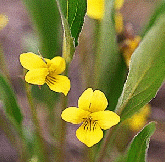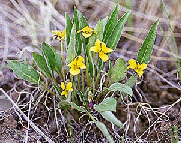

Nuttall's Violet
Viola Nuttallii (Pursh.)
It varies in flower color, leaf shape, and habitat preference. There are bilaterally, symmetrical, pansy like flowers. Nuttall's violet most commonly has bright, yellow petals with dark, purple lines leading to the mouth of the flower. A sac at the back of the flower conceals the nectar. The leaves are one to four inches long, elliptical, and often slightly toothed. It flowers in May and June, ranging from the upper steppes into open forests and onto mountain ranges. It exists throughout the sagebrush steppes, except in the drier habitats.
Food Uses: The leaves and flowers are both
edible. The flowers are eaten fresh, candied, and used for garnish on
salads or desserts. They are also used a flavoring or coloring for jams,
jellies, preserves, syrup, or vinegar. The leaves are used as salad greens
or as thickeners. Both leaves and flowers are steeped to make tea or
fermented for wine.
Caution: should be used in moderations and large
quantities can cause stomach upsets.
Medicinal Uses: The violet is rich in vitamins A & C. It is used in many ways: in teas to relieve the effects of asthma, heart palpitations, bronchitis, and fevers; as a gargle it will relieve sore throats or coughs, and in poultices or salves for rashes, eczema, and bruises.
